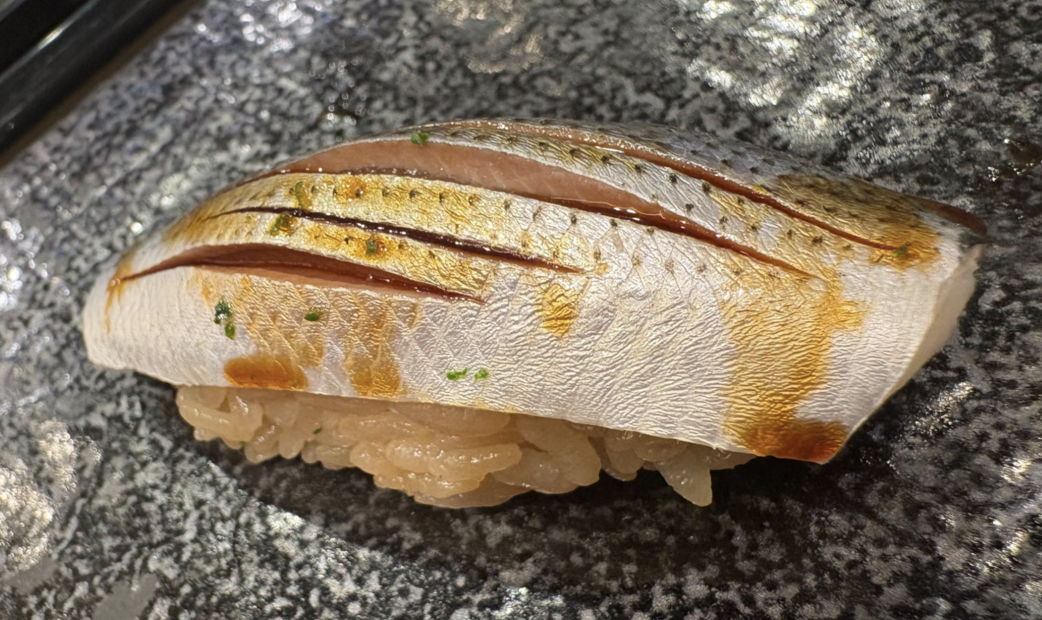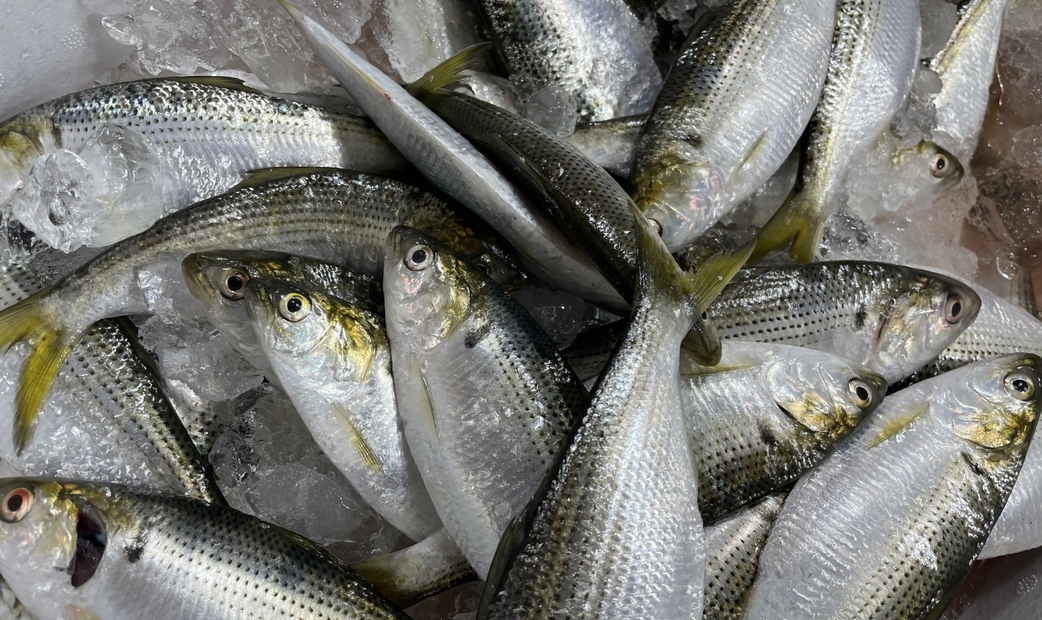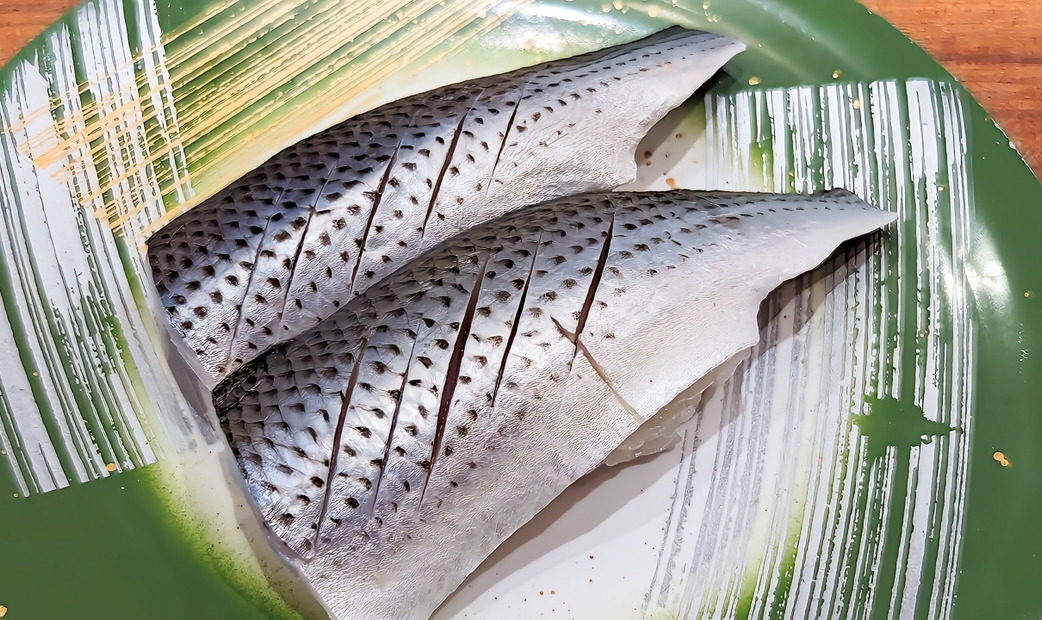
Kohada Sushi | What is Kohada, the Essential Topping in Edomae Sushi?
Michelin Official Partner OMAKASE Editorial Team introduces what kohada fish is, how kohada is prepared and eaten in Edomae sushi, and sushi restaurants in Tokyo where you can enjoy kohada.
What is Kohada?
Characteristics of Kohada Fish

Kohada refers to young konoshiro fish that are about 7-10 centimeters in size. Kohada belongs to the herring family (Clupeidae) within the herring order (Clupeiformes). It is characterized by a flat body with silvery, shimmering skin. In English, this fish is called "gizzard shad." Konoshiro is a fish whose market value decreases as it grows larger, becoming difficult to eat due to numerous small bones when fully grown. In Japan, the fish is given different names depending on its size and growth stage. These types of fish are known as "shusse-uo" (fish that advance through different stages).
What is Shusse-uo?
Shusse-uo (literally "fish that rise in rank") refers to fish in Japan that change names as they grow. This tradition is unique to Japan and stems from the custom where samurai would change their names as they advanced in rank. In addition to kohada, other well-known "shusse-uo" fish include buri (yellowtail) and suzuki (sea bass).

Kohada
Fish measuring about 7-10 centimeters in size are called kohada. It is one of the representative ingredients of Edomae sushi, and there's a saying that "only those who can properly appreciate kohada are true sushi connoisseurs." In Edomae sushi, kohada is salt-cured to remove excess moisture and then vinegar-marinated to dissolve the small bones before being used as sushi topping. Since the salt-curing and vinegar-marinating techniques and timing greatly reflect the sushi chef's skill, it is sometimes said that you can judge a sushi chef's ability by eating their kohada. While vinegar-marinated kohada can also be eaten as sashimi, in most cases it is a fish consumed almost exclusively as sushi. At sushi restaurants, kohada is often served either as "maru-zuke kohada" (whole fish marinated) or "katami-zuke kohada" (filleted and marinated with the backbone removed), but in both cases, one piece of fish is used to make one piece of sushi.
Sinko
Kohada measuring less than 7 centimeters are called "shinko." Shinko can only be caught around July, and in Edomae sushi, it is considered a representative summer ingredient that heralds the arrival of the season. Shinko is extremely expensive, sometimes fetching prices of nearly 100,000 yen per kilogram. This is more expensive than Japan's highest-grade bluefin tuna. There is no way to eat shinko other than as sushi, so if you want to taste it, you must visit a high-end sushi restaurant during its peak season. Due to its small size, shinko is difficult to process and requires skilled technique. While kohada is handled at almost all Edomae sushi restaurants, shinko can only be eaten at first-class renowned establishments. Because shinko is small, 2-4 pieces are used to make one piece of sushi. Like kohada, it is commonly served after being salt-cured to remove excess moisture and then vinegar-marinated. The taste is refreshingly tangy from the vinegar, without the fishy smell characteristic of raw fish, and it is considered to have a better aroma than kohada.

Nakazumi
Kohada measuring about 10-12 centimeters are called "nakazumi." At this size, the small bones become hard, making the fish very difficult to eat, and the characteristic fishy smell becomes more noticeable, significantly reducing its value. It is rarely served at sushi restaurants. However, with proper vinegar-marinating, it can be eaten without worrying about the small bones.

Konshiro
.jpg)
Kohada measuring 15 centimeters or larger are called "konoshiro." Konoshiro are fatty and delicious from November to February, but they have many small bones and a distinctive fishy smell. However, when properly processed, they can be eaten deliciously. For smaller konoshiro, it is recommended to salt-cure them to remove excess moisture, then vinegar-marinate them to dissolve the small bones before eating. In this case, rather than marinating the whole fish, it's better to remove the backbone and marinate it as fillets. Larger ones around 30 centimeters are best salt-grilled. The larger they become, the more difficult it is to deal with the small bones, so in most cases they are commonly eaten salt-grilled. They are fatty and delicious. Also, because they are inexpensive, konoshiro are popular fish that often appear on Japanese family dinner tables.
Peak Season for Kohada
The peak season for kohada is generally considered to be during the winter months from November to February when it tastes best. While kohada can be caught year-round, it is particularly delicious from November to February when it has good fat content. However, kohada from July to September is also considered delicious, because kohada is a fish that tastes better the younger it is, so the period from July to September when shinko develops into kohada is thought to be just right for optimal flavor. Kohada from July to September doesn't have much fat, but you can enjoy the original refreshing taste and aroma that kohada naturally possesses.
History of Kohada sushi
Kohada is one of the representative ingredients of Edomae sushi, and it is believed that the technique of vinegar-marinating it for use as nigiri sushi topping was devised during the Edo period (1800s). Vinegar-marinating not only removed the small bones but also improved preservation, making it ideal as a sushi ingredient. Meanwhile, in the Kansai region, kohada was used as an ingredient for pressed sushi. Battera, which remains one of the most popular pressed sushi in Kansai cuisine today, is currently made with mackerel, but when it was originally devised in the late 1800s, it was pressed sushi made with konoshiro. However, over time, as the catch of konoshiro decreased and prices rose, it was substituted with mackerel.
Kohada Production Areas
There are mainly four production areas for kohada in Japan. While kohada is basically a fish found everywhere, kohada from these particular regions are considered especially delicious.
- Tokyo Bay Area: It has been used as sushi topping for Edomae sushi since ancient times. Kohada from Tokyo Bay is characterized by soft skin and sweetness.
- Shizuoka Prefecture Area: Those caught around the lake called Lake Hamana are famous. Shinko in particular is renowned, and due to its high quality, it is traded at higher prices than those from other production areas.
- Seto Inland Sea: Kohada caught in the Seto Inland Sea is characterized by distinctive aroma and umami. The catch volume is also large.
- Kyushu: Compared to those from Tokyo Bay, the skin is harder but it is said to have less fishy smell.
Kohada Was Once a Despised Fish
Kohada was once disliked in Japan and was nicknamed "neko-matagi" (cat-skipper). Neko-matagi means a fish that even cats, who love fish, show no interest in. Kohada was difficult to eat due to its characteristic fishy smell and numerous small bones, and had low market value. However, even such a fish can be elevated by Japanese sushi chefs into a sushi topping that becomes central to Japanese sushi culture.
How to Eat Kohada Other Than as Sushi
When eating kohada other than as sushi, the small bones and characteristic fishy smell make it difficult to consume. However, smaller ones become easier to eat when salt-cured and vinegar-marinated. Larger sizes can be eaten deliciously when salt-grilled. There are also variations like frying or simmering, but from the author's experience, salt-grilling or sushi are the most delicious preparations.
Decorative Knife Work
Kohada has a beautiful silvery appearance, but decorative knife work is applied to make it look even better. Particularly in recent years, as visual presentation has become more important, more restaurants have begun applying decorative knife work. Making cuts with a knife to make the fish easier to eat is called "hidden knife work" (kakushi-bōchō).
How to Eat Kohada in Japan
Kohada is one of the representative sushi toppings of Edomae sushi. However, it is rarely seen in supermarkets or conveyor belt sushi restaurants. To enjoy delicious kohada in Japan, it is best to visit sushi restaurants that carry on the tradition of Edomae sushi.
Fine Dining Sushi Restaurants in Tokyo Where You Can Enjoy Kohada
Here are some top fine-dining sushi restaurants in Tokyo where you can savor kohada as part of their omakase (chef’s choice) courses.
*Please note that ingredient availability may vary depending on the season.
Sushi Masashi (鮨 将司)
A Michelin-starred sushi restaurant that specializes in traditional Edomae sushi techniques. Kohada is served as part of the omakase course, perfectly vinegared to achieve a balance of acidity, umami, and subtle sweetness.
- Operation hours
- Lunch: 12:00 PM -
Dinner: 5:30 PM - 8:00 PM - Regular holiday
- Wednesdays, Sundays, Public Holidays (Others, Irregular Holidays)
- Price range
-
Lunch: USD 272.23 - USD 311.12
Dinner: USD 272.23 - USD 311.12 - Address
- 7F, Gaien Icho no Mori, 2-9-9 Kita-Aoyama, Minato-ku, Tokyo
- Nearest station
- Gaienmae Station
- Directions from station
- 3 minutes walk from Gaienmae Station
- Payment methods
- Credit card available
- Seats
- Counter 10 Seats
Room 4 Seats - Awards
-
Michelin
-
Davide4.8Posted on :11/12/2025
-
Noah5.0Posted on :11/06/2025
-
Gook Chackis5.0Posted on :10/28/2025
Edomae Sushi Hanabusa (江戸前鮨 英)
This restaurant faithfully follows Edomae sushi techniques, using different vinegars for each type of fish. For kohada, they carefully balance the salt and vinegar to enhance the natural umami. With a focus on Tokyo Bay’s ingredients, they maintain the tradition of "starting with tuna, ending with tuna," and always include kohada in the course.
- Operation hours
- 5:00 PM - 10:00 PM (Last Order 8:30 PM)
- Regular holiday
- Saturdays
- Price range
- Dinner: USD 248.11 - USD 256.67
- Address
- Akasaka Residential Hotel 1F, 9-1-7,Akasaka, Minato-ku, Tokyo
- Nearest station
- Akasaka station,Nogizaka station,Roppongi Station,Roppongi 1-chome Station
- Directions from station
- 7 minutes walk from Akasaka station
8 minutes walk from Nogizaka station
9 minutes walk from Roppongi Station
10 minutes walk from Roppongi 1-chome Station - Payment methods
- Credit card available
- Seats
- Counter 8 Seats
- Awards
-
Michelin
-
Hemal Mehta5.0Posted on :11/20/2025
-
Lars Osterberg5.0Posted on :08/07/2025
-
Allen5.0Posted on :06/02/2025
Sushi Ichijo (鮨 一條)
Known for using red vinegar in their rice and offering kohada with a firm vinegary cure typical of Edomae sushi. They also use kelp marination to enhance the smooth umami flavor. The vinegar is slightly stronger, providing a sharp acidity and a classic Edomae flavor that highlights the chef's craftsmanship.
- Operation hours
- Lunch: 12:00 PM - 2:00 PM
Dinner: 5:30 PM - 7:00 PM - Regular holiday
- Wednesdays ・Sundays
- Price range
-
Lunch: USD 155.56 - USD 233.34
Dinner: USD 233.34 - USD 358.84 - Address
- 1F Okuda Building, 3-1-3 Higashi Nihonbashi, Chuo-ku, Tokyo
- Nearest station
- Bakuroyokoyama Station
- Directions from station
- 3 minutes walk from Bakuroyokoyama Station
- Payment methods
- Credit card available
- Seats
- 8 Seats
- Awards
-
MichelinAwards
-
Kristina5.0Posted on :11/14/2025
-
Kristina Tunander5.0Posted on :10/30/2025
-
Edward T4.7Posted on :10/04/2025
Tachiguizushi Akira (立喰い寿司 あきら)
A standing sushi bar by the upscale restaurant Sushi Shoryu in Shirokane Takanawa. They offer high-quality sushi at a great price, using ingredients from the renowned tuna supplier Yamayuki. Kohada is on the menu, and you can enjoy it a la carte, with the option to try multiple pieces.
- Operation hours
- Lunch: 11:45 AM -
Dinner: 05:15 PM - - Regular holiday
- Irregular Holidays
- Price range
-
Lunch: USD 77.78 - USD 91.92
Dinner: USD 77.78 - USD 91.92 - Address
- B1F, 3-8-5, Shinbashi, Minato-ku, Tokyo
- Nearest station
- Shimbashi Station, Uchisaiwaicho Station
- Directions from station
- 6 minutes walk from Shimbashi Station
7 minutes walk from Uchisaiwaicho Station - Payment methods
- Cash, Credit card
- Seats
- 7 Seats
-
AC5.0Posted on :06/29/2025
-
Scott5.0Posted on :06/16/2025
-
良祐5.0Posted on :05/18/2025
Sushi Kakizaki (すし柿崎)
An Edomae sushi restaurant that offers an omakase-only menu. They carefully select seasonal kohada and prepare it with a perfect balance of salt and vinegar for a delicate vinegared finish. The kohada has a sharp, bold umami flavor, allowing you to experience the true essence of the Edomae sushi tradition.
- Operation hours
- 5:30 PM - 10:00 PM (L.O.)
- Regular holiday
- Sundays, Public Holidays
- Price range
- Dinner: USD 155.56 - USD 155.56
- Address
- Yutaka Building 1F, 2-8-11 Nihonbashi Ningyocho, Chuo-ku, Tokyo
- Nearest station
- Ningyocho Station
- Directions from station
- 3 minutes walk from Ningyocho Station
- Payment methods
- Cash, Credit card
- Seats
- 8 Seats
-
Tim Dahnke5.0Posted on :05/27/2025
-
G.M.5.0Posted on :03/04/2024


